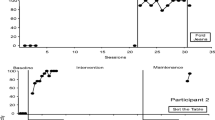Abstract
This study examined the effectiveness of point-of-view video modeling in a forward-chaining procedure to teach a 4-year-old boy with autism to serve himself an afternoon snack. Task analysis was undertaken, and the task was divided into 3 phases with 1 video produced for each phase. A changing criterion design was used to evaluate the effects of the intervention on the participant’s ability to independently prepare and serve himself Weetbix. The results indicated that the combination of point-of-view modeling and forward chaining was effective in teaching the child to serve himself a snack without any prompting. The results also indicated that although the skill was maintained at follow-up, generalization to snacks other than Weetbix and to a different setting was limited. Parents reported satisfaction both with the procedures undertaken and with the outcomes of the intervention.

Similar content being viewed by others
References
Alcantara, P. R. (1994). Effects of videotape instructional package on purchasing skills of children with autism. Exceptional Children, 61, 40–55.
American Psychiatric Association. (1994). Diagnostic and statistical manual of mental disorders (4th ed.). Washington, DC.
Cannella-Malone, H., Sigafoos, J., O’Reilly, M., De la Cruz, B., Edrisinha, C., & Lancioni, G. E. (2006). Comparing video prompting to video modeling for teaching daily living skills to six adults with developmental disabilities. Education and Training in Developmental Disabilities, 41(4), 344–356.
Catania, C. N., Almeida, D., Liu-Constant, B., & DiGennaro-Reed, F. D. (2009). Video modeling to train staff to implement discrete-trial instruction. Journal of Applied Behavior Analysis, 42(2), 387–392.
Cooper, J. O., Heron, T. E., & Heward, W. L. (2007). Applied behavior analysis (2nd ed.). Upper Saddle River, NJ: Pearson Education, Inc.
Estes, A., Munson, J., Dawson, G., Koehler, E., Zhou, X. H., & Abbott, R. (2009). Parenting stress and psychological functioning among mothers of preschool children with autism and developmental delay. Autism, 13(4), 375–387.
Graves, T. B., Collins, B. C., & Shuster, J. W. (2005). Using video prompting to teach cooking skills to students with moderate disabilities. Education and Training in Developmental Disabilities, 40(1), 34–46.
Hine, J. F., & Wolery, M. (2006). Using point-of-view video modeling to teach play to preschoolers with autism. Topics in Early Childhood Special Education, 26(2), 83–93.
Jowett, E., Moore, D. W., & Anderson, A. (2012) Using an instructional iPad-based video prompting package to teach numeracy skills to a child with an autism spectrum disorder. Developmental Neurorehabilitation 1–9. Early Online.
McCoy, K., & Hermansen, E. (2007). Video modeling for individuals with autism: A review of model types and effects. Education and Treatment of Children, 30(4), 183–213.
McDonnell, J., & McFarland, S. (1988). A comparison of forward and concurrent chaining strategies in teaching laundromat skills to students with severe handicaps. Research in Developmental Disabilities, 9(2), 177–194.
Pierce, K., & Schreibman, L. (1994). Teaching daily living skills to children with autism in unsupervised settings through pictorial self-management. Journal of Applied Behavior Analysis, 27(2), 471–481.
Shipley-Benamou, R., Lutzker, J. R., & Taubman, M. (2002). Teaching daily living skills to children with autism through instructional video modeling. Journal of Positive Behavior Interventions, 4(2), 166–177.
Shukla-Mehta, S., Miller, T., & Callahan, K. J. (2010). Evaluating the effectiveness of video instruction on social and communication skills training for children with autism spectrum disorders: A review of the literature. Focus on Autism and Other Developmental Disabilities, 25, 23–36.
Sigafoos, J., & Green, V. A. (2007). Technology and teaching. New York: Nova Science Publishers, Inc.
Sigafoos, J., O’Reilly, M., Cannella, H., Edrisinha, C., Cruz, B. D. L., Upadhyaya, M., et al. (2006). Evaluation of a video prompting and fading procedure for teaching dishwashing skills to adults with developmental disabilities. Journal of Behavioral Education, 16(2), 93–109.
Sigafoos, J., O’Reilly, M., & Cannella, H. (2005). Computer-presented video prompting for teaching microwave oven use to three adults with developmental disabilities. Journal of Behavioral Education, 14(1), 189–201.
Taylor, B. A., Levin, L., & Jasper, S. (1999). Increasing play-related statements in children with autism toward their siblings: Effects of video modeling. Journal of Developmental and Physical Disabilities, 11(3), 253–264.
Tereshko, L., MacDonald, R., & Ahearn, W. H. (2010). Strategies for teaching children with autism to imitate response chains using video modeling. Research in Autism Spectrum Disorders, 4(3), 479–489.
Wolery, M., Barton, E. E., & Hine, J. F. (2005). Evolution of applied behavior analysis in the treatment of individuals with autism. Exceptionality, 13(1), 11–23.
Wolf, M. M. (1978). Social validity: The case for subjective measurement or how applied behavior analysis is finding its heart. Journal of Applied Behavior Analysis, 11(2), 203–214.
Author information
Authors and Affiliations
Corresponding author
Rights and permissions
About this article
Cite this article
Shrestha, A., Anderson, A. & Moore, D.W. Using Point-Of-View Video Modeling and Forward Chaining to Teach a Functional Self-Help Skill to a Child with Autism. J Behav Educ 22, 157–167 (2013). https://doi.org/10.1007/s10864-012-9165-x
Published:
Issue Date:
DOI: https://doi.org/10.1007/s10864-012-9165-x




